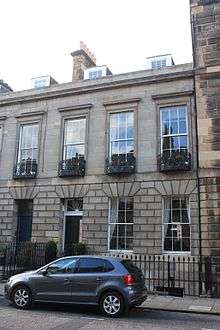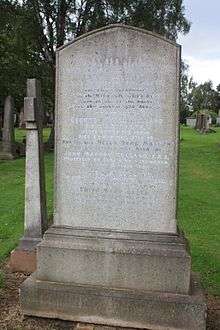John Masson Gulland
Prof John Masson Gulland FRS FRSE FRIC (1898 – 1947) was a Scottish chemist and biochemist. His main work was on nucleic acids, morphine and aporphine alkaloids. His work on electrometric titration was important in the foundation of principles leading to the discovery of the DNA double helix.[1] He established the Scottish Seaweed Research Association and the Lace Research Council.
Life


He was born at 6 Alva Street in Edinburgh’s west end, the only son of Dr George Lovell Gulland and Helen Orme Masson, on 14 October 1898. His maternal grandfather was David Masson and his maternal uncle was David Orme Masson. His paternal uncle was John William Gulland MP. John’s father later became Professor of Medicine at Edinburgh University.[2]
He attended Edinburgh Academy 1906 to 1917 and was then conscripted into the army in the First World War. He applied for a commission and served as a 2nd Lieutenant in the Royal Engineers. He was assigned to the Divisional Signals Company and saw little if any enemy action. After the war he won a Carnegie Research Scholarship and entered academia, firstly studying at St Andrews University then Manchester University before joining the Dyson Perrins Laboratory at Oxford University where he graduated MA then Edinburgh University where he gained a BSc in 1921. He became a Demonstrator in Chemistry at Balliol College in Oxford University in 1924 and gained a doctorate (from St Andrews University) in 1925. He was then promoted to Lecturer in Organic Chemistry in Oxford.[3]
In 1927 he was elected a Fellow of the Royal Society of Edinburgh. His proposers were Sir James Walker, George Barger, Alexander Lauder, and Ralph Allan Sampson.[4] In 1931 he moved to the University of London as a Reader in Biochemistry, also acting then as Senior Biochemist to the Lister Institute. In 1936 he moved to the University of Nottingham as Professor of Chemistry (the Jesse Boot Chair).
In the Second World War he worked for the Ministry of Home Security as Gas Advisor 1939 to 1943[5] and the Ministry of Supply 1943 to 1945. He was elected a Fellow of the Royal Society of London in 1945.
In 1947 he became Research Director for the Institute of Brewing. His career was however cut short. He was killed in the Goswick rail crash near Berwick-on-Tweed on 26 October 1947 aged 49.[6]
He is buried in the Grange Cemetery in south Edinburgh with his parents and uncle, John William Gulland.
Family
In 1924 he married Ruth Madeline Ida Russell, daughter of Sir James A. Russell. She was a fellow chemistry student whom he met in Edinburgh. They had two daughters.[7]
References
- ↑ The Path to the Double Helix: The Discovery of DNA, by Robert Olby
- ↑ BIOGRAPHICAL INDEX OF FORMER FELLOWS OF THE ROYAL SOCIETY OF EDINBURGH 1783 – 2002 (PDF). The Royal Society of Edinburgh. July 2006. ISBN 0 902 198 84 X.
- ↑ https://www.jstor.org/stable/768912?seq=1#fndtn-page_scan_tab_contents
- ↑ BIOGRAPHICAL INDEX OF FORMER FELLOWS OF THE ROYAL SOCIETY OF EDINBURGH 1783 – 2002 (PDF). The Royal Society of Edinburgh. July 2006. ISBN 0 902 198 84 X.
- ↑ http://onlinelibrary.wiley.com/doi/10.1002/j.2050-0416.1947.tb01338.x/pdf
- ↑ http://www.biochemj.org/content/43/2/161
- ↑ http://www.biochemj.org/content/43/2/161